The Battle of Bay Trail-D: GIGABYTE J1900N-D3V and ASUS J1900I-C Reviewed
by Ian Cutress on October 17, 2014 10:00 AM EST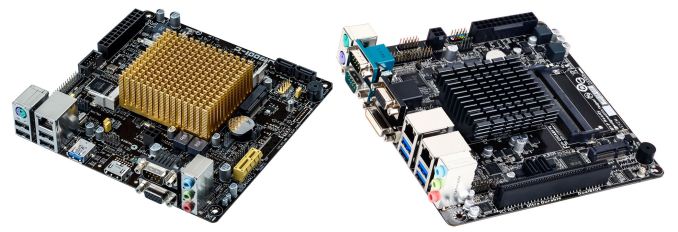
All the recent talk of Haswell-E and high-end refreshes has obscured the more casual computing market. The Bay Trail platform uses Intel’s Atom based Silvermont cores and competes directly against AMD’s Kabini for integrated computing, digital signage and cheap computing models. Today we compare two mini-ITX Celeron J1900 based motherboards: the GIGABYTE J1900N-D3V at $85 and the ASUS J1900I-C at $92, as well as the SoC itself.
Bay Trail-D Overview
Intel’s Atom Silvermont based architecture covers four SoC areas:
- Smartphones, in the form of Merrifield and Moorefield
- Tablets, Notebooks and Embedded in the form of Bay Trail
- Microservers and Storage in the form of Avoton
- Network and Communications in the form of Rangeley
We tested the C2750 eight-core Avoton SoC in the ASRock C2750D4I, a system oriented around maximum DRAM and storage in a mini-ITX form factor, and reported on GIGABYTE’s 46x C2750 Avoton server back at Computex 2014. The microserver market is apparently ripe for Avoton, but Bay Trail makes the desktop and tablet spaces a little more confusing.
Bay Trail comes in four forms:
- Bay Trail-D, for Desktop Systems at 6W to 20W
- Bay Trail-I, for Embedded and Automotive at 5W to 10W
- Bay Trail-M, for Mobile and Netbooks at 4W to 7.5W
- Bay Trail-T, for Tablets and Hybrids at 2W
We have covered Bay Trail in Mobile and Tablets, such as the ASUS Transformer Book T100 that has the Atom Z3740 Bay Trail-T, but the casual desktop space is still an interesting market. ECS’ LIVA is a perfect example of this: Ganesh’s review of the LIVA with the 4.5W Celeron N2806 Bay Trail-M shows that with enough innovation, some interesting designs can be produced.
Today’s review focuses on the Celeron J1900, a quad core 10W Bay Trail-D with Intel Ivy Bridge HD Graphics (6 EUs). The CPU has a base frequency of 2.0 GHz with a 2.42 GHz Turbo mode, 2 MB of L2 cache and support for dual channel DDR3L-1333. The J1900 was one of the targets of AMD’s AM1 Kabini launch earlier in the year, where the two traded blows on functionality:
| AMD Athlon 5350 vs. Intel Celeron J1900 | ||||
| Athlon 5350 | Celeron J1900 | |||
| CPU Architecture | Jaguar | Silvermont | ||
| CPU Cores | 4 | 4 | ||
| CPU Frequency | 2.05 GHz | 2.0 GHz / 2.4 GHz Turbo | ||
| GPU Cores | 128 SPs | 6 EUs | ||
| GPU Frequency | 600 MHz | 688 MHz | ||
| Memory Channels | Single | Dual | ||
| Memory Frequency | 1600 MHz | 1333 MHz | ||
| L2 Cache | 2 MB | 2 MB | ||
| TDP | 25 W | 10 W | ||
| Price | $59 | $82 | ||
AMD’s main power point for Kabini was the upgradable platform, due to Intel’s Bay Trail involving soldered on CPUs. Memory compatibility is traded, with Intel supporting dual channel but at a lower frequency. Price is also a battleground, along with GPU cores, although Intel uses significantly less power (on paper).
Because Bay Trail-D is a BGA processor, this means that the processor and motherboard must be purchased in tandem. There are a number of Bay Trail-D combinations available for purchase:
$200 – Jetway JNF9M-2930 (Celeron N2930, Bay Trail-M)
$150 – Habey MITX-6771 (Celeron J1900, Bay Trail-D)
$118 – ASRock Q1900TM-ITX (J1900)
$99 – ASRock Q1900DC-ITX (J1900)
$85 – GIGABYTE J1900N-D3V (J1900)
$80 – ASUS J1800I-A (Celeron J1800, Bay Trail-D)
$79 – ASUS J1800I-C (J1800)
$76 – ASRock Q1900-ITX (J1900)
$75 – Foxconn D190S (J1900)
$70 – ASRock Q1900M (J1900)
$70 – ASRock Q1900B-ITX (J1900)
$63 – Biostar J1800NP (J1800)
$60 – ASRock D1800M (J1800)
$60 – ASRock D1800B-ITX (J1800)
$60 – ASUS J1800I-C (J1800)
Thus for this review, we chose two of what might be the most popular Bay Trail-D motherboards for home builds: two mini-ITX systems, the GIGABYTE J1900N-D3V and the ASUS J1900I-C. Both of these use the Celeron J1900 processor, whereby the J1900 sits in the middle of Intel’s Bay Trail-D offerings but is the top SKU with the Celeron nomenclature:
| Bay Trail-D Comparison | |||||||
| Cores | CPU Frequency |
TDP | L2 Cache | IGP | IGP Frequency |
Price | |
| Celeron J1750 | 2 | 2410 | 10W | 1 MB | HD (Ivy) | 688 / 750 | |
| Celeron J1800 | 2 | 2410 / 2580 | 10W | 1 MB | HD (Ivy) | 688 / 792 | $72 |
| Celeron J1850 | 4 | 2000 | 10W | 2 MB | HD (Ivy) | 688 / 792 | |
| Celeron J1900 | 4 | 2000 / 2420 | 10W | 2 MB | HD (Ivy) | 688 / 854 | $82 |
| Pentium J2850 | 4 | 2410 | 10W | 2 MB | HD (Ivy) | 688 / 792 | |
| Pentium J2900 | 4 | 2410 / 2670 | 10W | 2 MB | HD (Ivy) | 688 / 896 | $94 |
| C2550 (Avoton) | 4 | 2400 / 2600 | 14W | 2 MB | None | N/A | $86 |
| C2750 (Avoton) | 8 | 2400 / 2600 | 20W | 4 MB | None | N/A | $171 |
Four Silvermont cores at 2 GHz for 10W sounds impressive, especially when I think back a decade to what I had back at university, or the 35W Core 2 Mobile CPU I had in my last laptop. As we found with the C2750, single thread speed should be reasonable and while multithreaded applications can take advantage, it doesn’t replace an i3, but ultimately that is not the intended market. Both the GIGABYTE J1900N-D3V and ASUS J1900I-C are going for that base desktop market, where ‘some memory’ and ‘some storage’ are needed, such as digital signage, a basic HTPC or run-of-the-mill all-access government machines.
It is worth noting that for Bay-Trail D, there are two steppings of the processors:
The new C0 stepping allows Intel Quick Sync to be used, but aside from the change in stepping (B3 to C0) there is no other outward indication which version is going to be used unless you are a customer that deals with Intel directly. Even though our samples in this review were new, both contained the B3 stepping version of the SoC.
Nevertheless, some of the Bay Trail-D SKUs to come with a form of Intel Burst, allowing parts of the SoC to turbo depending on how power is needed:
The Bay Trail Chipset
Similar with AM1, the integration of the IO into the SoC means there is no formal south bridge to distribute the ports and all routing is via the SoC:
Here the System Agent negotiates data between the dual channel DDR3L memory controllers, the Silvermont dual core ‘modules’ and the graphics, supplied as 6 EUs based on the Ivy Bridge video architecture. Because the Bay Trail SoC supports far fewer I/O connections compared to our usual foray into consumer based motherboard/CPU combinations, a mini-ITX is enough to almost fit them all.
The full block diagram for the J1900N-D3V is:
The SoC allows four PCIe 2.0 lanes from the chipset, which the manufacturer can use network connections or other IO controllers for. Here GIGABYTE has used two for Realtek NICs, one for a PCIe to PCI bridge and a mini-PCIe for a WiFi card or similar. The SoC supports two SATA 3 Gbps and a single USB 3.0 port, with this GIGABYTE motherbaord using a Renesas hub on that USB 3.0 to expand the offering to four.
Here is where Bay Trail comes across an issue. The system is designed to be cheap and competing with Kabini, meaning that motherboard manufacturers cannot fill the product up with controllers that cost a lot. It would be interesting if the PCIe lanes were used for additional SATA controllers, allowing for a large storage system, but that ends up being exactly what the C2750D4I is. Also, the decision here on the GIGABYTE to use a PCI slot will be for legacy use, as the latest graphics card available that uses PCI would be a HD 5450 or GT610/430.
Legacy connectors are always a touchy subject. Some motherboard reviews on products with a PS/2 or PCI slot might end up with a comment wondering why they still exist. The answer lies in industry, because upgrading that $1,000 PC is cheaper than upgrading the $5,000,000 bit of 15-year old equipment it is connected to. Bay Trail-D, even though is offered to the public, has a use in these motherboards for industry, so GIGABYTE and ASUS have to cover the bases. There are a few key points to consider in this respect:
- Does it have the right connectors?
- Does it cost a lot?
- Is it easy to set up?
- Is it responsive enough?
- Will it compute as much as is needed in a reasonable time?
The last two points end up being the usual reason for upgrading. For example, back in the lab I worked in several years ago our vintage equipment (an older version of this) ran on Pentium 4 machines but required a legacy slot for the proprietary communication and control card it ran on. In order to upgrade, it had to meet the above criteria. This is why legacy still exists.
Back to the review: we are putting both the GIGABYTE J1900N-D3V and the ASUS J1900I-C through their paces for usability as well as the J1900 SoC for responsiveness. These boards are in the $85-$95 mark, providing a competitive price point against AMD’s Kabini. Motherboards at the cheaper end of the spectrum tend to be worked on by less people, purely because the profit margins are low. Both the motherboards in this review are dealing with the fact that they have to include the SoC on the motherboard at the point of sale. Intel lists the price of the J1900 as $82, meaning that these SoCs are actually sold at a discount or in a discounted-revenue strategy, or the motherboard manufacturers are getting them severely discounted in order to make cents per sale.


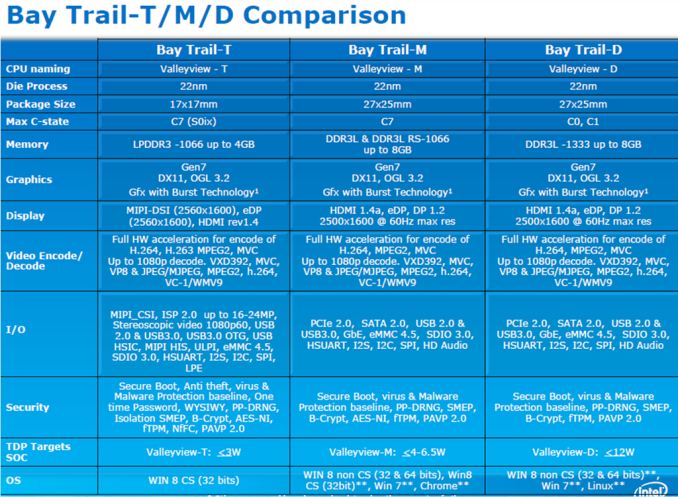
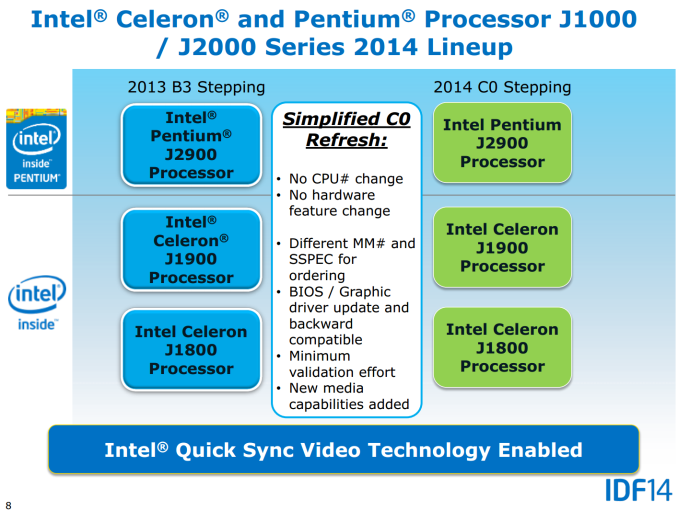
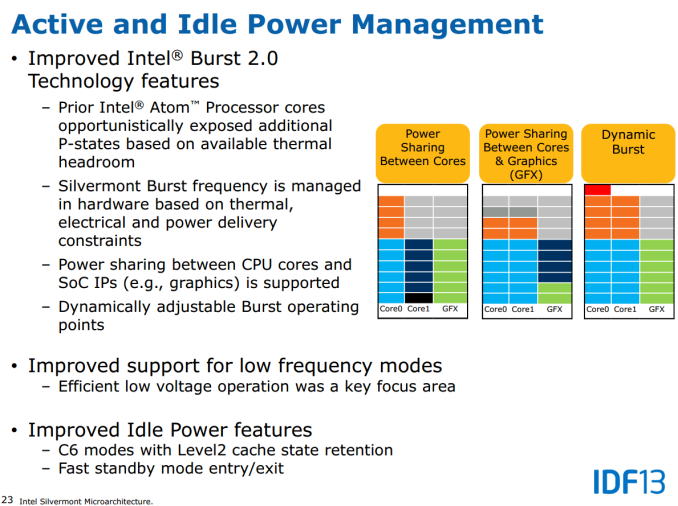
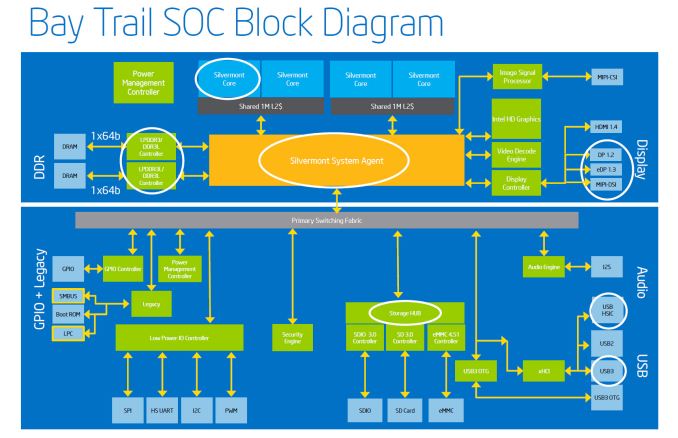
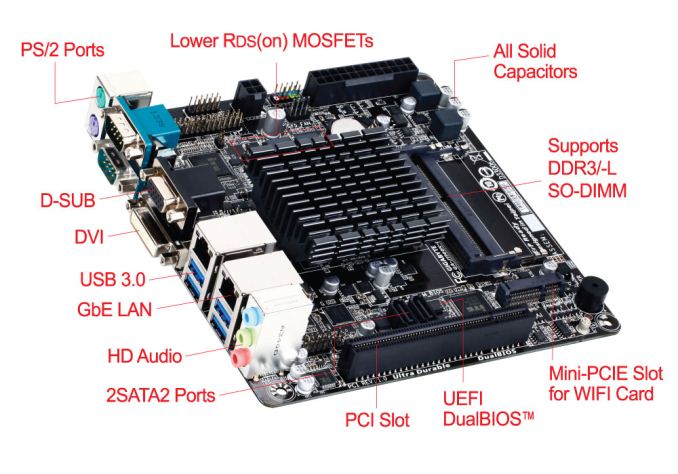
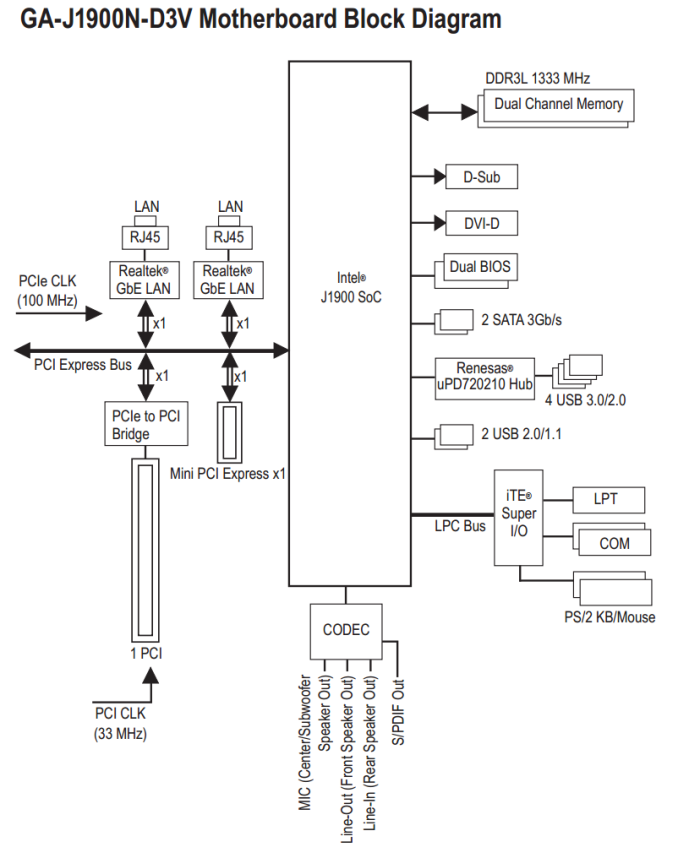








60 Comments
View All Comments
Flunk - Friday, October 17, 2014 - link
Yes, but that's like comparing a man with two broken legs to a man with no legs. Yes, the man with the broken legs is faster, but neither is going to be competing in any footraces anytime soon. These are not really suitable for PC gaming.Slap the two of them into tablets and the AMD will run Candy Crush better, but this is the desktop and neither can really manage anything on that level.
AJSB - Friday, October 17, 2014 - link
I said *LIGHT* gaming....i also specified a certain resolution up to 1366x768 (forget about 1920x1080).It all depends the kind of titles it plays....many indies will play just fine...and so it will MANY of the "old" titles like CoH (NOT CoH2), CoD2, BF2,etc. at those resolutions....lot's of people still play at least CoD2 online (and doesn't have those crazy UAV/HELIs in MP) and theres lots of mods for CoH and BF2 to play online or offline (i actually prefer play those offline).
Having said so, i play with a A6-5400K OC to 4GHz w/ iGPU OC to 950MHz and 8GB RAM at 2133MHz (CPU, iGPU and RAM were all undervolted to cut temps and power drain).
This rig gives me more freedom to play more demanding titles that i doubt a AM1 could.
PICman - Friday, October 17, 2014 - link
As usual, good review. However, as XZerg pointed out, the lack of idle and load power consumption is a problem. It's not just power consumption, but also heat generation and cooling. I guess the tests were run with a high wattage power supply, making idle power measurements meaningless?Non-working USB 3.0 ports is a big issue for me, also.
Torpe - Friday, October 17, 2014 - link
How well do these chips do with Quick Sync for Handbrake?Devo2007 - Saturday, October 18, 2014 - link
Did you read the part that mentioned these are the B3-stepping processors that don't have QuickSync?abufrejoval - Tuesday, October 21, 2014 - link
My GIGABYTE J1900N-D3V wasn't properly informed about that "fact" and just runs QuickSync anyway... Actually the initial Intel chipset drivers didn't enable QuickSync and I was quite hopping mad, because ARK had reported QuickSync support for the J1900, irrespective of the stepping.Actually I believe that the QuickSync feature gap lies between the J1850 and the J1900 and isn't stepping dependent.
abufrejoval - Tuesday, October 21, 2014 - link
Need edit!Fortgot to mention: It's a B3 stepping and runs around 80 frames/sec of DVD to MP4 conversion using DVDFab9 using QS. The QuickSync enabled Handbrake nightly builds I tried produced faulty output and the last stable release doesn't yet support QS.
Batch video conversion isn't exactly the forte of this device, but it would make it a credible Plex server once QS support for encoding is built in (for devices that need the run-time conversion).
Torpe - Tuesday, October 21, 2014 - link
Thanks for the answer.BillyONeal - Friday, October 17, 2014 - link
Windows 7 needs USB 3 drivers because Win7 has no USB 3 support. That was added in Win8.nathanddrews - Friday, October 17, 2014 - link
"Readers of our motherboard review section will have noted the trend in modern motherboards to implement a form of MultiCore Enhancement / Acceleration / Turbo on their motherboards."It's funny the difference between what turbo means today vs what it meant 30 years ago. My first PC (running Geo-DOS) had a "TURBO" button on the case that slowed it down. LOL
I've been using a Windows 8.1 (Bing) tablet with an Atom Z3735D and it's really impressive. It plays UT99 and Halo CE flawlessly at max res and settings (1280x800) and can stream games over Steam IHS. I played Halo for four hours nonstop and still had 30% battery left.